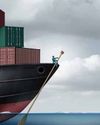The first session of Smart Logistics Summit held in New Delhi raised several concerns of the industry including the impact of GST on shipping cost, imbalance in import and export cargo moving at ports that complicates the positioning of empties, the need for establishing rail transshipment hubs to manage the rise in cargo when DFCs become operational and logistics challenges faced by customers in hinterland.

GST tax was not a new levy, but was a combination of various taxes that had been subsumed into it. The purpose was to create a unified common national market and this move was expected to contribute to the growth of the GDP as well as increase industrial production, clarified S K Rahman, Additional Director General of Goods and Service Tax, as he spoke of the impact of GST on shipping industry. He stated that the the endeavor of the Government is to simplify the GST rules as much as possible.
With regard to impact of GST on shipping charges he clarified that the cargo whether export or import is taxable, the tax would be applicable on the shipping charges too. A distinction has been made on the GST rate for national and international transportation.
In order to minimize the Government interaction with the trade, a special purpose vehicle called GSTM has been created to facilitate the people.
Sanjay Swarup, Director (International Marketing & Operations) Container Corporation of India, spoke of the problems faced by the industry. He said that 60 percent of the container business were concentrated in the northern hinterland for the west coast ports. Even though there was a network of terminals, direct connectivity, rolling stocks and state of art handling equipment, they have not seen a proportionate growth of cargo by rail from this region. Reasons attributed for the laggard growth in the container business are as under.
Imbalance of cargo import and export and high logistics costs There is disproportionate movement of cargo in the ports as well as the ICDs (Inland Container Depots). Some ports are more import oriented whereas other ports have large volumes of export cargo. Due to this skewed ratio empty containers need to be re-positioned to cater to the export cargo. This incurs additional expenditure which is passed on to the customers.
Bu hikaye Maritime Gateway dergisinin February 2018 sayısından alınmıştır.
Start your 7-day Magzter GOLD free trial to access thousands of curated premium stories, and 9,000+ magazines and newspapers.
Already a subscriber ? Giriş Yap
Bu hikaye Maritime Gateway dergisinin February 2018 sayısından alınmıştır.
Start your 7-day Magzter GOLD free trial to access thousands of curated premium stories, and 9,000+ magazines and newspapers.
Already a subscriber? Giriş Yap

Impact Of Covid-19 On Shipping And Logistics
Industry stalwarts discuss threadbare the prevailing logistics and supply chain scenario and issues in clearing cargo during the COVID-19 lockdown

Digital Platforms Defy Lockdown
Digital trading modules such as eNAM are enabling farmers to move their produce from farm to market even during the lockdown

GARMENT TRADE TRAMPLED
As retailers face a shutdown in US and Europe, the cascading affect has caused mass cancellation of orders in Bangladesh

TRADE RESUMES WITH CHINA
While India has allowed uninterrupted movement of imports into Nepal even during lockdown, China is reopening its borders as it emerges from the pandemic
LESS HUMAN INTENSIVE, MORE DATA DRIVEN
AI provides transformational opportunity for logistics industry by improving customer experience, operational efficiency, faster turnaround time and lower cost while ensuring security and transparency. Macro environment requires industry to transform to be less human intensive, agile and data driven, all of which can be accelerated by AI adoption, shares Gangadhar Gude, Founder & CEO, atai.ai

SHAKEN AND STIRRED
The COVID-19 pandemic has partially paralysed the logistics and supply chain, but the industry is still deterred to ensure supply of essentials continues

TRADE STUCK, ECONOMY SLOWS DOWN
Sri Lankan economy slows down as trade deficit widens and supply chain disrupts amidst lockdown

LENDING INTELLIGENCE TO SUPPLY CHAIN
If you’re shipping millions of dollars’ worth of pharmaceuticals, high-end electronics, expensive seafood, or precious metals, what would you be willing to pay for the ability to ‘ask’ your shipment where it is right now and whether it’s ok? What would you pay for a freight smart enough to raise an alarm before it spoils? Artificial Intelligence enables that and much more…

CONTAINER LINES SIGNAL ‘SOS'
As the per-unit cost of operations increases many lines are forced to blank sailings which has hit their bottom line real hard. The Government and Terminal Operators therefore need to actively consider reduction in Vessel Related Costs

IMO 2020 And The Covid-19 Curse
The COVID-19 outbreak has shaken and stirred the already volatile bunker market. While the refiners adjust their capacities and shipping lines choose their path to compliance, the market dynamics are yet to reach an equilibrium